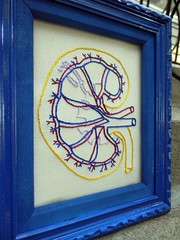
One step closer to finding a therapeutic solution to a complex disease
Researchers from Mount Sinai School of Medicine have identified a regulator protein that plays a crucial role in kidney fibrosis, a condition that leads to kidney failure. Finding this regulator provides a new therapeutic target for the millions of Americans affected by kidney failure. The research is published in the March 11 issue of Nature Medicine.
Led by John Cijiang He, MD, PhD, Professor of Nephrology and Pharmacology and Systems Therapeutics; and Avi Ma’ayan, PhD, Assistant Professor of Pharmacology and Systems Therapeutics at Mount Sinai School of Medicine, the research team studied three mouse models of kidney fibrosis: one group of mice contained HIV viral proteins incorporated into their genome; the second group was injected with a high dose of folic acid; in the third mouse model, kidney filtration was blocked in one kidney. All of these factors cause kidney fibrosis.
The researchers gathered the genetic material of the mice and compared it to the genetic material of mice that did not have kidney fibrosis. Using a new computational systems biology algorithm and software called Expression2Kinases — developed by the Ma’ayan Laboratory at Mount Sinai — the results from these experiments were analyzed. They found that HIPK2, a protein kinase, or regulator, was highly active in the mice with kidney fibrosis. HIPK2 regulates the way certain genes are expressed and when HIPK2 is highly active this leads to kidney fibrosis. Drs. He and Ma’ayan also found that when they eliminated HIPK2, fibrosis was less prominent and the condition of the mice significantly improved.
“Our findings have important implications for people with kidney diseases, patients I treat every day,” said Dr. He. “Protein kinases like HIPK2 are highly effective therapeutic targets. We look forward to exploring this further.”
Read more . . .
Bookmark this page for “Kidney Disease” and check back regularly as these articles update on a very frequent basis. The view is set to “news”. Try clicking on “video” and “2” for more articles.







